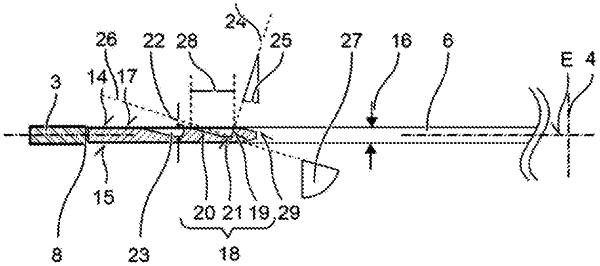| CPC B23D 61/025 (2013.01) [B23D 47/123 (2013.01)] | 5 Claims |

|
1. A ring saw blade (1), comprising:
a flat annular support (7) which has a side face (14) and an outer circumference (8);
one or more cutting elements (3) which are disposed along the outer circumference (8);
a first annular groove (18) which is recessed into the side face (14) and which has a radially inner flank (19) and a radially outer flank (20);
wherein the radially inner flank (19) is conical and wherein a first cone (24) describing the radially inner flank (19) has a first half opening angle (25) of between 10 degrees and 30 degrees;
wherein the radially outer flank (20) is conical, wherein a second cone (26) describing the radially outer flank (20) has a second half opening angle (27) of between 50 degrees and 80 degrees, wherein the radially outer flank (20) extends continuously below the second cone (26), and wherein the second cone (26) is perpendicular to the radially inner flank (19) and extends through a point on the radially inner flank (19) which is furthest away from the side face (14);
wherein a profile of the first annular groove (18) is asymmetric such that a sum of the first half opening angle (25) of the first cone (24) that describes the radially inner flank (19) and the second half opening angle (27) of the second cone (26) that describes the radially outer flank (20) is greater than 90 degrees and less than 120 degrees, the radially inner flank (19) contributes less than 20% to a width (28) of the first annular groove (18) and a remainder of the width (28) of the first annular groove (18) is occupied by the radially outer flank (20) and a groove base (21), and the width (28) of the first annular groove (18) is at least three times as great as a depth (22) of the first annular groove (18).
|